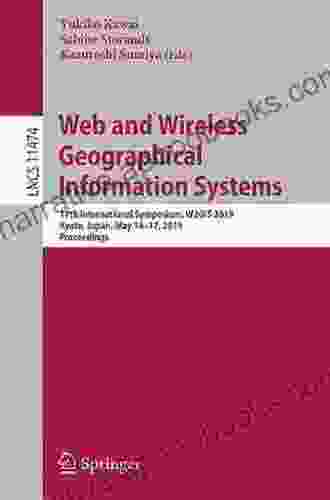Web and Wireless Geographical Information Systems: A Comprehensive Guide

Geographical Information Systems (GIS) have become an essential tool for understanding and managing the world around us. They allow us to collect, store, analyze, and visualize spatial data, providing us with a powerful way to explore complex relationships and make informed decisions.
4.7 out of 5
| Language | : | English |
| File size | : | 44230 KB |
| Text-to-Speech | : | Enabled |
| Enhanced typesetting | : | Enabled |
| Print length | : | 442 pages |
| Screen Reader | : | Supported |
The advent of the web and wireless technologies has revolutionized GIS, making it possible to share and access spatial data more easily than ever before. Web GIS and Wireless GIS are now widely used in a variety of applications, including:
- Land use planning
- Natural resource management
- Emergency response
- Transportation planning
- Public health
This article provides a comprehensive overview of Web and Wireless GIS, from their history and evolution to their current applications and future potential. It also includes detailed information on the various technologies and standards used in Web and Wireless GIS, as well as their advantages and limitations.
History and Evolution of Web and Wireless GIS
The roots of Web GIS can be traced back to the early days of the internet, when researchers began to explore ways to share and access spatial data over the web. In the mid-1990s, a number of commercial Web GIS applications were released, and by the early 2000s, Web GIS had become a widely adopted technology.
Wireless GIS emerged in the late 1990s, as the popularity of mobile devices such as smartphones and tablets increased. Wireless GIS applications allow users to collect, store, analyze, and visualize spatial data in the field, providing them with a powerful tool for real-time decision-making.
Technologies and Standards for Web and Wireless GIS
Web and Wireless GIS rely on a variety of technologies and standards to function. These include:
- Web mapping services (WMS): WMS is a standard for sharing geospatial data over the web. It allows users to view and query data from a variety of sources, including government agencies, universities, and private companies.
- Web feature services (WFS): WFS is a standard for sharing feature data over the web. It allows users to create, edit, and delete features, as well as perform spatial queries.
- GPS: GPS is a satellite-based navigation system that allows users to determine their location. GPS data can be used to create maps, track assets, and guide navigation.
- GIS software: GIS software is used to create, edit, and analyze spatial data. There are a variety of GIS software packages available, including both commercial and open source software.
Advantages and Limitations of Web and Wireless GIS
Web and Wireless GIS offer a number of advantages over traditional GIS, including:
- Increased accessibility: Web and Wireless GIS can be accessed from anywhere with an internet connection, making it possible to share and collaborate on spatial data more easily.
- Reduced costs: Web and Wireless GIS are often less expensive than traditional GIS, as they do not require the Free Download of expensive software or hardware.
- Increased flexibility: Web and Wireless GIS can be customized to meet the needs of specific users and applications.
However, Web and Wireless GIS also have some limitations, including:
- Limited functionality: Web and Wireless GIS applications may not have the full functionality of traditional GIS software.
- Security concerns: Web and Wireless GIS applications may be vulnerable to security breaches, as they are accessible over the internet.
- Data quality issues: Web and Wireless GIS applications may rely on data from a variety of sources, which may not be of consistent quality.
Future of Web and Wireless GIS
Web and Wireless GIS are rapidly evolving technologies, and their future potential is vast. Some of the key trends that are likely to shape the future of Web and Wireless GIS include:
- Increased use of mobile devices: The increasing popularity of mobile devices such as smartphones and tablets is driving the development of new Web and Wireless GIS applications that are specifically designed for use on these devices.
- Integration with other technologies: Web and Wireless GIS are becoming increasingly integrated with other technologies, such as cloud computing and artificial intelligence. This integration is enabling the development of new and innovative applications that can solve complex problems.
- Increased use of open data: The increasing availability of open data is making it easier for developers to create new Web and Wireless GIS applications. Open data can be used to create maps, track assets, and analyze trends.
Web and Wireless GIS are powerful tools that can be used to understand and manage
4.7 out of 5
| Language | : | English |
| File size | : | 44230 KB |
| Text-to-Speech | : | Enabled |
| Enhanced typesetting | : | Enabled |
| Print length | : | 442 pages |
| Screen Reader | : | Supported |
Do you want to contribute by writing guest posts on this blog?
Please contact us and send us a resume of previous articles that you have written.
 Book
Book Novel
Novel Page
Page Chapter
Chapter Text
Text Story
Story Genre
Genre Reader
Reader Library
Library Paperback
Paperback E-book
E-book Magazine
Magazine Newspaper
Newspaper Paragraph
Paragraph Sentence
Sentence Bookmark
Bookmark Shelf
Shelf Glossary
Glossary Bibliography
Bibliography Foreword
Foreword Preface
Preface Synopsis
Synopsis Annotation
Annotation Footnote
Footnote Manuscript
Manuscript Scroll
Scroll Codex
Codex Tome
Tome Bestseller
Bestseller Classics
Classics Library card
Library card Narrative
Narrative Biography
Biography Autobiography
Autobiography Memoir
Memoir Reference
Reference Encyclopedia
Encyclopedia Jim M Spinks
Jim M Spinks Emma Jayne
Emma Jayne Barton Jennings
Barton Jennings Tamara Jones
Tamara Jones Elizabella Baker
Elizabella Baker Allen O Donoghue
Allen O Donoghue Cj Lyons
Cj Lyons Nitzan Shoshan
Nitzan Shoshan Gillian Andrews
Gillian Andrews Tommy J Curry
Tommy J Curry Matt Mason
Matt Mason Jerry Lindberg
Jerry Lindberg Rick Sapp
Rick Sapp Muthende Nduucu
Muthende Nduucu Lougaya Laure Dehan
Lougaya Laure Dehan Alison Peirse
Alison Peirse Mark Nolan
Mark Nolan Marc Stanford
Marc Stanford Helen Wattley Ames
Helen Wattley Ames Michael Ashby
Michael Ashby
Light bulbAdvertise smarter! Our strategic ad space ensures maximum exposure. Reserve your spot today!

 Garrett PowellPlaying Texas Two Step With Hybrid System: Unlock the Synergies for Business...
Garrett PowellPlaying Texas Two Step With Hybrid System: Unlock the Synergies for Business...
 Patrick HayesUnveiling the Intriguing Life of John Garvey: A Legendary Figure in the San...
Patrick HayesUnveiling the Intriguing Life of John Garvey: A Legendary Figure in the San... Dillon HayesFollow ·18.5k
Dillon HayesFollow ·18.5k Reginald CoxFollow ·4k
Reginald CoxFollow ·4k Abe MitchellFollow ·5.6k
Abe MitchellFollow ·5.6k Asher BellFollow ·2.5k
Asher BellFollow ·2.5k Henry David ThoreauFollow ·11.6k
Henry David ThoreauFollow ·11.6k Gregory WoodsFollow ·6.9k
Gregory WoodsFollow ·6.9k Colin RichardsonFollow ·15.5k
Colin RichardsonFollow ·15.5k Jason ReedFollow ·12.2k
Jason ReedFollow ·12.2k

 F. Scott Fitzgerald
F. Scott FitzgeraldUnravel the Enigmatic Murder of Mary Russell: A...
Prologue: A Grisly Discovery In the...

 Connor Mitchell
Connor MitchellLittle Quilts: Gifts from Jelly Roll Scraps
Embrace the Art...

 Harold Powell
Harold PowellPoverty Survival Hope In An American City: A Pulitzer...
A testament to the resilience of the human...

 Ray Blair
Ray BlairConfronting Global Warming: Population, Resources, and...
Global warming is one of the most pressing...

 Gary Cox
Gary CoxStyle Your Most Authentic Self and Cultivate a Mindful...
Unlock Your True...

 Caleb Long
Caleb LongEmbark on a Colorful Patchwork Adventure: Discover 20 To...
Step into the captivating world of...
4.7 out of 5
| Language | : | English |
| File size | : | 44230 KB |
| Text-to-Speech | : | Enabled |
| Enhanced typesetting | : | Enabled |
| Print length | : | 442 pages |
| Screen Reader | : | Supported |








